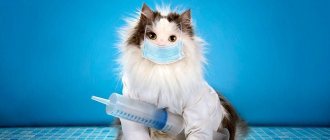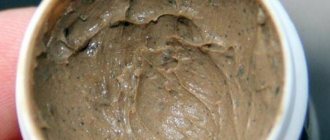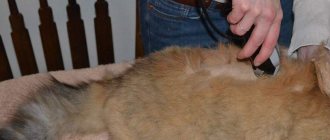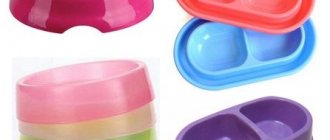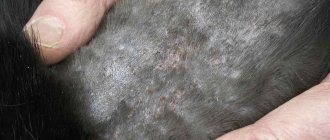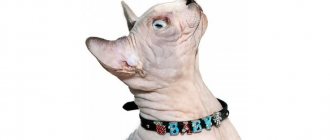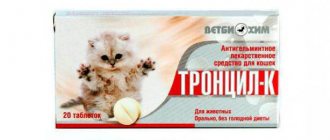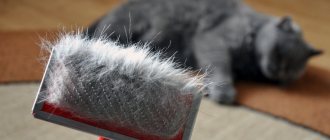Ringworm: symptoms and treatment at home
Ringworm does not manifest itself immediately; the incubation period can last up to three months. The first signs of the disease are the appearance of round spots without hair. At first the spots are small in size, but gradually they increase in size and occupy more and more surface area on the cat’s body.
Initially, lichen appears on the ears, face, tail and paws of the animal. With ringworm, the affected areas of the skin are covered with gray, oily scales.
The disease occurs in different forms. The easiest of them is superficial, the more complex and dangerous is the deep form of ringworm. It most often affects kittens, older cats and animals with weak immunity.
The third form of the disease is atypical. With this form of ringworm, isolated areas without hair form on the cat's body. What makes recognizing the disease difficult is that ringworm of this form can be confused with ordinary abrasions or abrasions.
The superficial form of lichen is also difficult to recognize, since upon external examination, especially if the cat is fluffy, the spots are not always easy to notice. Is there a cure for lichen in cats? Yes, and below we will look at how to do this.
Treatment
If your pet is at home almost all the time, this does not mean that the fungus is not scary for him.
Rather, on the contrary, in such cats the disease develops faster and is more difficult. How to cure cat ringworm? It is recommended to isolate a sick cat or limit its presence on a bed, sofa, or chair as much as possible. This must be done because lichen can spread to humans.
The first thing you need to do to treat a sick pet is to cut the hair near the affected area and treat the spots with brilliant green or iodine.
Recommendations
When the symptoms of ringworm become obvious, which manifest themselves in the form of a rash and unbearable itching, the animal must be quickly isolated from people and other pets. It is not advisable to bathe and comb it, because you can only worsen its condition. In particular, spread the infection to all parts of her body.
All prescribed medications must be applied with rubber gloves to avoid contracting the disease yourself. After all, everyone often asks whether it is dangerous for people. The answer to this is clear: yes!
The only difference that can be observed is that those people who have a fairly strong immune system may not even notice how they survive this infection. It should be noted that pregnant women, children, the elderly, or those who have a fairly weak immune system are at risk.
It is believed that a cat can only get ringworm if it spends most of its time outside. But this is a wrong assumption. After all, you can bring home the spores that carry lichen along with dust or even dirt that will be on your shoes.
How to treat tinea versicolor?
Weeping eczema is a disease caused by a malfunction of the cat's immune system.
Weeping eczema does not develop as a result of exposure to fungi; it is provoked by the following factors:
- External - the presence of parasites (ticks, fleas), exposure to detergents, lack of proper hygiene.
- Internal - disturbances in the functioning of the nervous system, hormonal imbalances, stress.
Symptoms
Symptoms of weeping eczema are painless red spots on the pet's skin with an increase in body temperature in areas of inflammation. Then such spots will be covered with dense blisters with exudative fluid.
As a result of properly selected treatment, such blisters can resolve, and if left untreated, they can open and become infected, resulting in the formation of ulcers.
After the ulcers rupture, the skin in the area of inflammation becomes moist. In turn, the correct approach to treatment and access of air to the inflammation contributes to the fact that the area of weeping lichen will quickly become covered with a crust, which will soon fall off in the form of scales.
Treatment
It is worth recognizing that weeping eczema in a cat is quite difficult to treat, so achieving a complete recovery can be difficult. However, the health of your four-legged friend is worth any effort!
So, what should you do if your cat has shingles? It is very important to consult a veterinarian before starting treatment, who will determine the cause of the development of this disease.
General recommendations in the treatment of weeping lichen may include the use of antiseptic and astringent agents that can significantly improve the cat’s skin in areas of inflammation. The following ointments have proven effective in the treatment of lichen: salicylic, ichthyol, sulfuric, tar, YaM ointment.
Indications for use of ointments
Skin lesions in animals can be fungal or viral in nature. The most common ringworm in cats is caused by the pathogenic fungi Trichophyton and Microsporum. Other, less common varieties of lichen include:
- pink (viral in nature);
- red flat (etiology unclear);
- multi-colored (pityriasis) (fungal nature);
- weeping (eczema).
Ointments of various types can be used to treat any of these types of diseases, except pityriasis rosea. No specific treatment has been developed for it. Your cat needs good nutrition and a healthy immune system. A symptom of this type of disease is a multitude of pink spots located throughout the body, which over time become yellowish. Wrinkles on the skin begin to appear in the affected areas.
The ointment is an effective remedy for the most common type of lichen - ringworm. A fungal infection most often affects the face, the area behind the ears, paws and tail. In some areas, the skin begins to become covered with scales and peel off, and baldness in the affected area is observed (as if six were cut off). If a pet owner notices such abnormalities on the skin, it is necessary to immediately begin treatment, since the disease causes severe discomfort to the animal. The fungus can quickly spread on surfaces and be transmitted to humans, so it is advisable to isolate the cat from children (who have not yet developed immunity to fight the fungal infection).
If the disease cannot be cured with local medications, then the help of a specialist will be required. The veterinarian may decide to prescribe oral medications. Most often they are used in severe or severely advanced cases.
Important! Treatment of lichen with any tablets is prohibited for pregnant and lactating cats and kittens.
Treatment of pityriasis rosea
At the initial stage, pityriasis rosea in cats looks like a pink spot with clear boundaries and constant peeling. Constant itching causes great discomfort to the cat. In most cases, after a few days the pink spot will be covered with a dry crust.
Such spots tend to spread to other parts of the pet’s body.
Treatment
Since the development of pityriasis rosea is often associated with a decline in the cat's immune strength, treatment is focused on strengthening and maintaining the cat's immunity. Fortunately, this type of lichen does not require special treatment.
Often, all that is needed is to provide the cat with adequate nutrition, which would include a complex of microelements and vitamins. During the treatment of pink lichen, it is strictly forbidden to wash the animal. In addition, it is important to completely protect the cat from sunlight.
Over the course of 1-2 months, this type of lichen goes away on its own.
Diagnostics
If a fungal infection is suspected, the cat is brought to the veterinary clinic, as to treat lichen under the supervision of a specialist. First, the doctor conducts a diagnosis to rule out other skin diseases and determine the type of lichen. A clinical examination is not enough for this; 3 methods are usually used:
- Wood's fluorescent lamp examination. The affected areas turn green under the influence of rays, but the accuracy of this method is only 50%: not all types of fungus give off a fluorescent glow and vice versa - sometimes healthy areas can become colored due to medications and chemicals. An uninfected animal may also have spores on its fur that glow.
- Examination under a microscope. To do this, they take damaged hairs and scrapings from the surface of the lesion - fungal cells are sometimes found in them. The accuracy of this method is approximately 70%: if no traces of infection are found, this does not mean that it is absent.
- Mushroom cultivation. This is the most accurate method, but it takes about 3 weeks. Affected samples of animal skin are kept in a special nutrient medium, its changes are observed, and then the grown cultures are studied under a microscope.
At the same time, a blood and urine test is done to rule out other infections, viruses, and to find out the general state of health.
How to cure pityriasis versicolor?
Pityriasis versicolor is extremely contagious for both humans and other animals. It often begins as a small oval spot with a color that can range from pale yellow and pink to brown.
Subsequently, the spots quickly spread throughout the cat's body, merging together.
Treatment
Treatment of pityriasis versicolor requires a competent and responsible approach, therefore, if the first symptoms of the disease appear, you must urgently contact a veterinarian.
In the treatment of this type of lichen in cats, products containing enilconazole are used, for example, Imaverol. In severe cases, treatment of the cat with Lime Sulfur is prescribed.
Application and dosage
Treatment for onychomycosis can last from six to twelve months. In cases of severe infection, surgical declawing may be the only effective method of getting rid of the fungus.
Instructions for use of Terbinafine for cats contain information that treatment lasts approximately four to six weeks and is stopped only after a negative test result for a fungal infection is obtained. This is important because even if there are no symptoms of the disease, it can be positive.
The cat is considered recovered only after receiving a second negative culture result for the fungus four weeks after the end of the course of treatment with the drug. This is explained by the fact that in the 1st study, the negative result was due to the persistence of Terbinafine in the skin fragments and hairs that were taken for analysis.
In practice, repeat analysis is rarely done, as cat owners refuse to have it performed.
Terbinafine tablets for cats should be used in a dose of 20 to 30 mg per 1 kg of animal body weight once a day, a little later - every other day. The duration of treatment averages 32-34 days. It is recommended to give the drug to the cat during feeding.
Small kittens that may be harmed by the tablets should be treated externally, lubricating the affected areas with ointment or cream. The duration of treatment depends on the pet’s immunity - the stronger it is, the shorter the course will be.
Terbinafine is the best option for a drug used to treat microsporia in pets. In any case, treatment should be selected by a veterinarian based on the individual characteristics of the cat, the degree of advanced disease, the age of the animal and test results.
Treat with home remedies
An alternative method of treating lichen in cats is the use of proven methods of traditional medicine. Despite the fact that they are less expensive, their effectiveness has been proven only in the early stages of the disease.
Their use is justified if there is no veterinary pharmacy nearby or there is no money to purchase pharmacological drugs.
How to treat lichen in cats at home? Consider popular recipes:
- Iodine. Treat the affected areas and the area around them with iodine or brilliant green twice a day.
- A mixture of olive oil and lemon juice. Mix the ingredients in equal proportions and heat slightly. Dip tampons into the medicinal mixture and apply to the affected areas 4 times a day.
- Celandine. Rub freshly squeezed celandine juice into the affected areas 4-5 times a day.
How to treat lichen in a cat at the initial stage of development of the disease
When choosing treatment, the veterinarian pays attention to the severity of the fungal infection, the state of the animal’s immunity, and the size of the areas affected by the disease. Thanks to a comprehensive approach, it is possible to select the appropriate method and eliminate the cause of the development of skin pathology. At the first signs of the disease, effective external preparations for lichen in cats and therapeutic and prophylactic vaccines can be prescribed. Learn more about the two methods.
Ringworm vaccine for cats
To treat animals, including those with trichophytosis, antifungal vaccines are used, which aggravate the infection and promote the rapid removal of crusts from the surface of microtic lesions. Vaccinations are contraindicated for pregnant and lactating cats and kittens under 2 months of age. Before giving the injection, deworming must be done 10 days before (even for a kitten). Vaccine prices are affordable, since many are produced in Russia. Popular drugs that attack fungi in a short time:
- Vakderm;
- Polivac;
- Microderm;
- immunostimulants Ribotan, Anandin.
Sulfur ointment for microsporia
How to treat lichen fungus in cats? Use sulfur ointment - a local remedy for microsporia in people and pets. The drug is available in glass jars of 25 g and 1 kg. Price in pharmacies – from 30 rubles. The active ingredient of the ointment is sulfur, which, after absorption, forms hydrogen sulfide, sulfur dioxide. Under the influence of these substances, antimicrobial activity is achieved and the epidermis is restored. How to treat ringworm in cats with ointment? You just need to smear a little product on the affected areas and around them by 2-4 cm 1-2 times a day. Treatment – at least a week.
- How to make your hair smooth
- Bio-down - filling for outerwear
- How to make a husband jealous and afraid of losing his wife - advice from a psychologist and men
Getting rid of the disease in a generalized form
In the presence of multiple lesions of the skin, it should be recognized that the disease has developed into a generalized form.
At the same time, the affected areas make up more than half of the cat’s body, which means there is a risk of developing a secondary infection. That is why the generalized form of lichen requires very serious therapy - in addition to the use of ointments, sprays, and vaccinations, the doctor must prescribe antifungal medications and oral agents.
What are the best products to use?
After diagnosing a generalized form of the disease, the following medications for cats are prescribed for lichen:
- Itraconazole . A drug that suppresses the vital activity of most types of fungi. Since Itraconazole is toxic, the dosage must be adjusted by a veterinarian.
- Griseofulvin is a tablet that is aimed at suppressing fungi. This remedy helps the cat’s body replace the affected tissues with new ones as soon as possible. The drug is prescribed in combination with rubbing alcohol, iodine, as well as ointments for lichen. It is convenient to mix the product into animal feed.
Description and properties of the drug
Terbinafine is a drug belonging to the allylamine group. The drug has a wide spectrum of action, but is most often used in the treatment of dermatomycosis and is effective against pathogens of onychomycosis.
Terbinafine is available in the form of cream, ointment and tablets; the main active ingredient in them is terbinfin, which allows you to relatively quickly cope with a fungal infection.
Terbinafine cream and ointment for cats is white in color and has a viscous, homogeneous consistency and is intended exclusively for external use.
The tablets are flat-cylindrical, white, scored and chamfered on one side.
Rules for the treatment of deprivation:
- Isolation of the cat. To prevent the spread of lichen spores around the house and infect people, the cat needs to be given a separate room. A sick animal is prohibited from lying on upholstered furniture and beds. To achieve maximum effectiveness of treatment, you should shave the affected areas on the cat’s body, taking 2-3 cm of healthy skin around the source of infection. If the lesion is too extensive, the fur must be shaved off completely. Instruments used for this purpose should be disinfected immediately after use or disposed of, otherwise they will serve as a source of fungal spread.
- Home disinfection. The place where a sick cat lives must be cleaned with water and a chlorine-containing disinfectant dissolved in it.
- Cat skin care. Areas affected by the fungus should be “laminated” or “terbizated” - treated with a medicinal product. During the healing process, crusts appear on the wounds, which need to be removed twice a day with soapy warm water. It is recommended to burn shaved fur and dead tissue.
To avoid re-infection with the fungus, the cat is given a prophylactic vaccination with Polivac or Vakderm.
Prevention
To keep your cat healthy, you will need to follow these guidelines:
- When purchasing a new pet, it is necessary to thoroughly examine it.
- Regularly thoroughly clean furniture with a weak bleach solution, since many types of microorganisms and fungi are sensitive to it.
- Constantly clean and disinfect your cat's habitat.
- It is advisable to protect the cat from walking outside.
- Keep your pet away from other cats.
It is worth noting that for the most effective treatment of lichen in cats, it should be prescribed by a veterinarian after a thorough examination of the animal.
Side effects
The following side effects may occur while taking the drug:
- nausea;
- headache and dizziness;
- disruption of the menstrual cycle;
- decreased amount of potassium in the blood and related heart failure;
- allergy to components;
- hair loss.
It is important to know that the use of the medication may affect the ability to drive vehicles and perform work that requires extreme concentration. In addition, it is not recommended to become pregnant during the course of treatment, so it is important to take all possible contraceptive measures. You should definitely inform your gynecologist if an unplanned conception of a child occurs while taking an antifungal drug.
Thus, knowing all the positive and negative aspects of the medicine, you can make a choice among medicines with a similar composition and principle of action. In other words, choose an analogue of Itraconazole.
Orungamin
This instruction for use describes the details of using one of the high-quality antifungal drugs of the new era. Also, the average assessment options, the range of diseases and the exact doses of the drug for treatment are indicated here.
About the medicine
“Orungamine” is a systemic antifungal (directed against infectious pathological fungi) medicine that is used to treat a huge number of antifungal infections and deep diseases.
Stable concentration in the blood and tissues provides a long-term effect on the pathogen and gives a chance, over time, to reduce the concentration of pathogenic components.
Components
Itraconazole is the main active ingredient that destroys the fungal cell membrane, stimulates the production of ergosterol (a substance that inhibits fungal reproduction and the creation of membranes) in the fungal cell. This process disrupts metabolic activity (metabolism in the cell).
Additional components (gelatin, starch, sucrose, indigo carmine, propylparaben) protect the clear structure of the capsule. Special chemical enzymes (chemical reaction enhancers) are needed to shorten the period before the drug takes effect.
Release form
Solid pharmacological forms (tablets, capsules). Contour blisters (packages of capsules) packed in cardboard packs and contain:
- 5 capsules - 1 pack;
- 5 caps. – 3 packs;
- 10 pieces each - 2 packs;
- 15 pcs. – 1 pack.
Capsules of 100 mg, with a pink body and a blue cap. The contents of the capsules are yellow or beige granules.
Length of administration and dosage
| Diseases | Single dose (mg) | Dose per day (mg) | Rate in days |
| Candidiasis of the vulva, vagina | 200-300 | 200-300 | 1-3 |
| Pityriasis versicolor | 200-300 | 200-300 | 1 Week |
| Ringworm (smooth skin) | 150-200 | 200 or 100 | 1-2 weeks |
| Fungal keratinization (keratitis) | 100-400 | 200 | 3 weeks |
| Onychomycosis (feet, hands) | 200 | 100-200 | 2 weeks |
| Oral candidiasis | 150 | 150 | 2.5 weeks |
| Patients with tumors, immunodeficiencies, leukemia (blood cancer), AIDS, after organ transplantation | Double dose | Double standard | The doctor determines the course |
| Localization | I week | II III IV weeks | V weeks | VI VII VIII weeks | IX week |
| Nail plates of the feet | starting technique | interval | second course | pause | 3rd year |
| Nail plates of brushes | first appointment | pause | repeat course | — | — |
Or shock therapy is used for affected nails. This type of treatment involves 2 courses per week of days (4 capsules per day). Additional prophylaxis – 3 months.
Systemic fungal diseases:
| States | Dosage per day, mg | At one time, mg | Duration |
| Aspergillus infection | 100-300 | 100-300 | 2-5 months |
| Systemic candidiasis (damage to organ systems) | 100-300 | 100-300 | 3-30 weeks |
| Deep and widespread forms | 400-600 | 200 | 2-6 months |
| Cryptococosis | 200 | 200 | 2-12 months |
| Cryptococcal meningitis | 400-600 | 200 | 2-12 months |
| Histoplasma infection | 200-400 | 200 | 8 months |
| Sporotrichosis infection | 200 | 100 | 3 months |
| Chromomycosis infection | 100-200 | 100-200 | 6 months |
| Paracoccidioidomycosis infection | 100 | 100 | 6 months |
| Blastomycosis infection | 100-400 | 100-200 | 7 months |
Price
15 capsules in a blister cost from 600 to 800 rubles. Residents of Ukraine can purchase the drug for 200-300 hryvnia. The relatively high price has a rational explanation, because such a medicine provides a guarantee of recovery and freedom from the status of an infectious carrier.
What does it help with?
This medicine acts against a whole list of diseases:
- mycosis of smooth skin;
- mycosis of the mouth;
- mycosis of the eyes;
- mycosis of the nail plates;
- candidiasis of different localization;
- pityriasis versicolor;
- aspergillosis;
- visceral mycosis (internal organs);
- cryptococosis.
Infections with a mass of different fungal pathogens have thousands of forms and courses of disease.
Symptoms
At the first stage of germination of the fungus, a rash forms. The affected area itches, the cat scratches, worries, and fusses. Small hairless spots appear, as if the fur was specially cut. Gradually they grow. The area freed from hair is covered with loose scales.
There are three forms of the disease:
- Superficial. Characterized by a few small hairless spots on the face or ears.
- Deep. The most dangerous. It affects young animals, old cats and individuals with weakened immune systems.
- Atypical. Observed in animals of long-haired breeds. Ringworm is mistaken for abrasion or bruising. At the beginning of the disease, the spots are invisible. The owner becomes suspicious of microsporia when, while combing the animal, they notice bald patches or areas of broken fur.
Kitten with ringworm

